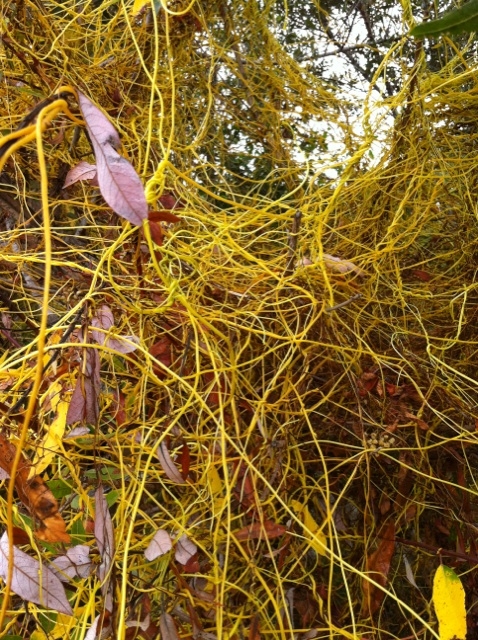
Japanese dodder, Cuscuta japonica recently found in Lompoc, Santa Barbara Co.
(Photo by: Matt Victoria, Santa Barbara Ag Commissioner's Office)
Japanese dodder is an exotic parasitic weed which is a high priority noxious weed in California. It was recently detected in a natural wooded area in Lompoc. It is the first time it is reported in Santa Barbara Co and the Ag Commissioner's office is taking an immediate action.
Biology:Japanese dodder, Cuscuta japonica is a parasitic plant that belongs to Convolvulaceae family (note that older literature refers to it as a member of Cuscutaceae family). It is a parasitic annual plant that has a slender, yellow stem with red spots and striations, and scale-like leaves. It produces haustoria (singular hostorium), which are root-like structures that penetrate the vascular tissue of the host and absorb nutrients and water. It can reproduce by seed and by vegetative means through fragments of the plant. Seed can germinate in soil, but the plant has to come in contact with a host to for the young shoot to survive beyond a few days. It appears that Japanese dodder seed produced in California is not viable and vegetative reproduction is the main source of propagation.
Host range: Japanese dodder has a wide host range that includes herbaceous annuals to woody shrubs and trees. Crop plants like corn, cucumber, egg plant, pea, pumpkins, soybean, and tomato, and ornamental shrubs, fruit and other trees are among the hosts that are parasitized by this weed.
Damage: Depending on the extent of infestation, damage can range from stunted growth to death. Japanese dodder growers faster and spreads to larger areas than the other dodders.
Dissemination: It is spread by equipment, birds, animals and people as seed and fragments of plant material. Gardening activities and improper composting and infested plant material can spread the weed. Intentional planting for medicinal purposes is thought to be a significant factor for the dissemination of this weed.
Management: Prevention of the infestation is the best way to manage Japanese dodder. Due to its current status a high priority regulated pest, one should not attempt to control or remove Japanese dodder if detected. It should be immediately reported to the local Ag Commissioner's office (805-681-5600 for Santa Barbara Co and 805-781-5910 for San Luis Obispo Co).
Detailed information on Japanese dodder biology, identification, and reporting the infestation can be found at the following sources.
http://ucanr.edu/articlefeedback
References:
Santa Barbara Co Ag Commissioner's Office: http://www.countyofsb.org/agcomm/wma.aspx?id=29344
UC IPM: http://www.ipm.ucdavis.edu/PMG/PESTNOTES/pn7496.html
CDFA Noxious Weed Information Project: http://www.cdfa.ca.gov/plant/ipc/noxweedinfo/noxweedinfo_jdodder.htm
Center for Invasive Species and Ecosystem Health: http://www.invasive.org/eastern/other/DicCusCjO01.pdf
